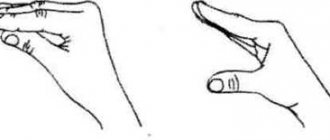Stages of speech therapy work to correct sound pronunciation
Tatiana Borisova
Stages of speech therapy work to correct sound pronunciation
Preparatory stage
Articulation. The set of movements and positions of the speech organs - lips, tongue, etc., necessary for the formation of sounds .
Developing correct articulation of a disturbed sound is possible if you have well-formed articulatory motor skills, i.e., the ability to control the organs of speech and speech breathing. It is necessary to learn to tense and relax the tongue, hold it in the desired position, direct the air stream in the right direction, and coordinate the coordinated work of various organs of articulation.
This purpose is served by articulatory gymnastics - a set of special exercises for the lips and tongue.
Articulatory gymnastics is designed to develop in a fun way the child’s ability to control his own speech organs: tongue, lips, lower jaw and speech breathing.
For such work , certain conditions must be met.
Performing articulatory gymnastics should be mandatory during the period of preparing articulatory structure and sound .
It should be carried out regularly.
Duration of classes is 3-5 minutes.
Exercises are performed at a moderate pace with mandatory visual control. It is advisable that both the child and the adult can be in front of the mirror: the adult shows a sample of the exercise, the child repeats after him.
The movements of the tip of the tongue and lips in the baby’s imagination can be associated with already familiar images, developing his imagination and emotional sphere, and turning difficult work into an exciting educational moment.
Sound production stage
Sound production is the process of forming articulation, teaching a child to pronounce a sound in an isolated sound. At the stage of sound production, the skill of correct pronunciation of an isolated sound , the auditory, kinesthetic image of the sound , and the visual perception of articulation is used.
At this stage, speech therapy work is carried out in the following areas: development of speech perception, formation of phonemic analysis, development of articulatory motor skills, work on direct sound .
The development of speech perception, as in the preparatory stage , is carried out using tasks for simulating syllables . Syllables with consonant clusters are offered (which are pronounced correctly)
.
The development of phonemic perception, analysis and synthesis presupposes the formation of the ability to isolate the sound being practiced in a word , determine its place, and differentiate it from other sounds , especially from those that are articulatory and acoustically distant. Taking into account the level of mastery of the phonemic side of speech, it is possible to work on complex forms of phonemic analysis: determine the number of sounds in words of the sound on it . It must be remembered that at this stage , phonemic analysis is carried out by children only on the basis of auditory perception of the word, without pronouncing it.
At the stage of sound production, much attention is paid to the development of speech motor skills (kinetic and kinesthetic basis of articulatory movements)
.
Work continues to consolidate speech breathing skills, develop the voice, and articulatory movements.
The development of articulatory motor skills is carried out in the form of articulatory gymnastics. Articulatory gymnastics is a specific set of exercises for the lips and tongue, preparing the correct pronunciation of sounds . The goal of articulatory gymnastics is to practice each element of the articulatory structure.
The set of articulatory exercises is determined by the normal articulation of sound and the nature of the defect. For each sound, a specific system of articulatory exercises is recommended.
Articulatory gymnastics is usually carried out by imitation, in front of a mirror. If movements fail, mechanical assistance is used. Subsequently, they move from passive execution of movements to active actions.
At the stage of sound production, the same requirements are imposed on articulatory exercises as at the preparatory stage . Movements of the organs of articulation must be accurate, smooth, without accompanying movements, performed with normal muscle tone, without excessive tension and lethargy. Attention is paid to a sufficient range of movements, to the ability to hold the position of the articulatory organs for a certain time, to the switchability of movements.
After practicing isolated elements, the movements are combined and included in a single articulatory pattern.
There are several ways to produce sound :
1. By imitation - based on the auditory image, on the visual perception of articulation. This is due to the fact that children have fairly well developed imitation. However, by imitation, most often it is possible to create a sound only when it is absent. In mentally retarded children, sound by imitation is extremely rare.
2. Mechanical method of placement using auxiliary means (spatula, probe, etc.)
.
With mechanical assistance, the articulatory organs are given a certain position. For example, a child pronounces the sound “s”, the speech therapist places a probe or spatula under the tongue and slightly lifts it towards the upper alveoli, a hissing sound . With this method, the child himself does not search; his organs of articulation only obey the actions of the speech therapist .
After long training, he takes the necessary position without mechanical assistance, helping himself with a spatula or finger. 3. Production from other sounds , correctly pronounced, without mechanical assistance. For example, the sound “s” can be placed from the sound “i”. It is suggested to pronounce the sound “and”, bite the side edges of the tongue with the molars, and blow on the back of the tongue so that the breeze “walks”
on the tongue.
4. Staging sound from the articulatory structure. For example, the sound “sh” can be placed from “cup”
.
The child is asked to make a “cup”
outside the oral cavity, remove it inside the mouth and blow on the tongue.
5. The mixed method of production is based on the combination of previous methods of sound .
Sound automation stage
From a physiological point of view, the stage of sound automation is the consolidation of conditioned reflex speech-motor connections on various speech material. The delivered sound is still very fragile ; the conditioned reflex connection without reinforcement can quickly collapse. Automating sound means introducing it into syllables, words, sentences, and coherent speech. Children with sound pronunciation have fixed stereotypes of incorrect pronunciation of words, sentences, etc.
to automating a given sound only when the child pronounces it in isolation completely correctly and clearly with prolonged or multiple repetitions. In no case should you introduce into syllables and words a sound that is not yet pronounced clearly enough, as this will only lead to the consolidation of incorrect skills and will not improve pronunciation.
Automation of the supplied sound must be carried out in a strict sequence:
automation of sound in syllables (direct, reverse, with a combination of consonants)
;
automation of sound in words (at the beginning of the word, middle, end)
;
automation of sound in sentences ;
automation of sound in tongue twisters , tongue twisters and poetry;
automation of sound in short and then long stories;
automation of sound in spoken language .
First of all, sound is included in syllables . A syllable is a simpler speech unit compared to a word. In addition, the syllables are meaningless; therefore, the child does not have stereotypes in the pronunciation of words, which facilitates their automation.
Automation of fricative sounds begins with direct open syllables , then continues in reverse and closed syllables. When fixing stop sounds and affricates, the sequence is different: first automation in reverse syllables, then in direct open ones. Later, the pronunciation of sounds in syllables with a combination of consonants is practiced.
At this stage, exercises are offered for pronunciation of syllables with stress transfer. At first, you should actively work on syllable tables .
Automation in words is first carried out based on syllables (sa - sad)
.
At the initial stages sound is consolidated , then words in which the sound is at the end and middle of the word. At first, the sound is automated in words that are simple in phonetic composition and do not contain broken sounds , then in words with a combination of consonants. To automate sound, they use the techniques of reflected repetition, independent naming of words from a picture, and reading of words. Useful tasks that direct the child to search for words containing a given sound (inventing words with a given
sound ) .
You should not limit yourself to just training sounds in words ; you need to introduce creative exercises, games, and move from pronouncing individual words to constructing phrases with them and short statements.
At this stage, sound is automated in phrases, phrases, sentences, connected texts, and colloquial speech. At first, sentences with moderate inclusion of sound , later automation is carried out on speech material saturated with this sound .
At this stage, work is also carried out on complex forms of sound analysis and synthesis , to develop the ability to isolate a sound in a word , determine its place in relation to other sounds (after which sound , before which sound ). This work contributes to the efficiency of the automation process. The ability to clearly and quickly determine the sound structure of a word is necessary for the correct and rapid completion of the automation stage .
In the process of automating sounds, work is carried out on the prosodic side of speech: on stress when automating sounds in syllables and words , on logical stress in the process of automating sounds in sentences , on intonation when fixing the pronunciation of sounds in a sentence , connected speech.
Along with the development of the phonetic-phonemic side of speech, at the stage of automation of sounds , the vocabulary is enriched, systematized, and the grammatical structure of speech is formed.
Speech sound differentiation stage
Work on differentiation of sounds is carried out in the following directions: development of auditory differentiation, consolidation of pronunciation differentiation, formation of phonemic analysis and synthesis.
It is especially important to differentiate phonetically similar sounds : hard and soft, voiced and voiceless, whistling and hissing, affricates and the sounds that make up them. The following sequence of sound : b - p, d - t, g - k, z - s, zh - sh, s - sh, z - zh, c - s, h - t, h - shch.
In the process of developing the differentiation of sounds, tasks are offered to imitate syllables , for example, when differentiating with –z: sa-za-sa, za-sa-sa, etc. An effective method of work is to determine the phonetic correctness of the word. Children are offered words that have phonetically similar sounds (ring - kolso, swallow - swallow, etc.)
.
Speech therapy work on differentiating mixed sounds includes two stages :
1) preliminary stage of work on each of the mixed sounds
2) the stage of auditory and pronunciation differentiation of mixed sounds .
At the first stage , the pronunciation and auditory image of each of the mixed sounds .
The work is carried out according to the following plan:
1. Clarification of sound based on visual, auditory, tactile perception, and kinesthetic sensations. For example, when clarifying the correct articulation of the sound c, you need to pay attention to its pronunciation: the lips are stretched as if in a smile, the tip of the tongue is behind the lower teeth. With the help of tactile sensation, it is clarified that when pronouncing this sound , a narrow cold stream of air is formed, the vocal folds do not tremble. is compared to the whistle of the wind .
2. Isolation of sound against the background of a syllable . Children learn to isolate sounds from a syllable by ear and in pronunciation, to distinguish between syllables with and without a given sound . For example, a speech therapist names syllables that include a given sound and do not have it . Children must raise a circle or letter and clap their hands if a given sound .
3. Formation of the ability to determine the presence of sound in a word . The speech therapist suggests words that include this sound and do not have it . Words with sounds that are similar acoustically and are mixed in pronunciation are excluded. The sound being studied must be associated with the corresponding letter. For the first time, a letter is introduced only after recognizing the sound in a different sound environment . In this case, the letter is associated not only with an isolated sound , but also with a phoneme, which generalizes various variants of a given sound , depending on its position in the word. Thus, the mechanical connection between a letter and an isolated sound , which can serve as an additional difficulty in mastering the continuous reading of syllables and words , as well as the correct reproduction of the structure of a word in writing.
To determine the sound in a word, you can offer children the following tasks: raise the letter to a given sound ; select pictures whose names contain a given sound ; match the given letter with pictures whose names contain the corresponding sound ; come up with words for a given sound .
4. Determining the place of a sound in a word : at the beginning, in the middle, at the end of the word, after which sound , before which sound .
5. Isolating a word with a given sound from a sentence
According to this plan, each of the mixed sounds .
At the second stage, a comparison of specific mixed sounds in pronunciation and auditory terms. Differentiation of sounds is carried out in the same sequence as the work to clarify the auditory and pronunciation characteristics of each sound , but due to the fact that the main goal of this stage is to distinguish sounds , speech material must include words with mixed sounds . At the stage of differentiation of sounds, a large place is given to the development of phonemic analysis and synthesis.
Sound setting [C]
The articulation of “C” is as follows:
- lips need to be stretched into a weak smile;
- bring your teeth closer, but do not close them;
- lean the tip of the tongue against the front teeth of the lower row, arch the tongue, resting its sides on the molars;
- create a strong and narrow air stream.
Before starting sound production, you should make sure that the child’s articulatory apparatus is ready to pronounce whistling sounds. For preparation, a set of special speech therapy exercises is used to improve the articulatory apparatus.
The sound “C” is placed in several ways:
- By imitation. Sitting with your child in front of the mirror, show how to pronounce the sound “C”.
- By imitation with game moments. For this method, visual aids and bright objects are used, with which you can imitate the sound “C”. For example, the balloon deflates - “SSSS”.
- Based on reference sounds. To learn to pronounce the sound “S”, a child must be able to pronounce the sounds “I” and “F”, which are the reference sounds for him.
- Mechanical setting. Using a spatula, the speech therapist sets the child’s tongue in the desired position and asks to gently but forcefully blow out the air.
The main thing is to give the child the opportunity to remember the position of the articulatory organs when playing the sound “C”, only then can it be automated in syllables, words and sentences.




